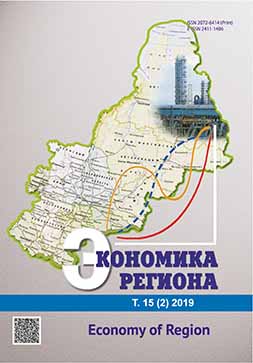ПРОСТРАНСТВЕННАЯ СТРУКТУРА ФОРМИРОВАНИЯ
ДОБАВЛЕННОЙ СТОИМОСТИ АРКТИЧЕСКИХ ТЕРРИТОРИЙ
Spatial Structure of the Formation of Value Added in the Arctic Territories
Author(s): Ekaterina Aleksandrovna ZakharchukSubject(s): National Economy, Human Geography, Rural and urban sociology
Published by: Институт экономики Уральского отделения Российской академии наук
Keywords: gross value added; arctic territories; system of national accounts; spatial development;
Summary/Abstract: The growing interest in the development of the Russian Federation’s Arctic territories affects various aspects of space exploration, including technological, legal, geopolitical, social and economic aspects. At the same time, when studying the Arctic’s economic development, little attention is paid to the issues of financial efficiency and imbalance of the various territories development, especially in the context of municipalities. Therefore, this study aims to develop a methodology for assessing the formation of the value added in the territories belonging to the Russian Federation’s Arctic belt, based on the International System of National Accounts (SNA). This system enables both the comparisons within the Russian Federation and between different countries. The paper summarizes the Russian and international practice in developing a methodology for calculating the value added in the local-level territories (municipalities) as close to the SNA methodology as possible. Based on the author’s model for building the System of Territorial Accounts, taking into account special features of the financial development of Arctic municipalities’, I have developed an original method for calculating the value added in the local territories. That method is based on using regional accounts tables for generating income by type of economic activity and including taxes on products(excise duties and mineral extraction tax) into income composition. The calculations for all Arctic municipalities for the period from 2013 to 2016 resulted in the main conclusions for the Russian Federation’s regions. I have revealed that almost half of the Gross Value Added of the Russian Federation’s Arctic Zone is formed in the municipalities of the Yamalo-Nenets Autonomous Okrug. The territory of Krasnoyarsk Krai is in second place, and municipalities of Murmansk oblast are in third place (exactly 10 %). The Republic of Komi, Sakha and Nenets Autonomous Okrug contribute to Gross Domestic Product (GDP) by about 7 %. In general, according to the presented data, in 2016 the municipalities formed value added in the amount of 4,272.3 billion rubles, which is about 5 % of Russia’s GDP. At the same time, the share of paid taxes on products is much higher and amounted to almost a quarter of all the Russian budget’s revenues, or more than 687 billion rubles. The study’s results can be applied by federal and regional governments, as well as local authorities in the Arctic territories when making management decisions on the development of Arctic’s municipalities, taking into account their influence on the formation and distribution of the value added in the territories.
Journal: Экономика региона
- Issue Year: 15/2019
- Issue No: 2
- Page Range: 391-408
- Page Count: 18
- Language: Russian

